Threads of Identity: Contributions of the Tehuana embroiderers
Social, Economic, and Cultural Impact of Women in Juchitán, Oaxaca (Mexico)
Keywords:
Zapotec embroiderers, social empowerment, cultural identityAbstract
The traditional embroidery of tehuana costumes is a central economic activity for many families in Juchitán Oaxaca, primarily carried out by women. Zapotec embroiderers weave threads of history by reproducing ancestral techniques, generating income that allows economic self-sufficiency and improves living conditions in their homes; this activity also energizes other local economic sectors by promoting the sale of textile materials; they are proud guardians of the cultural preservation of their ancestral traditions by promoting the use of the tehuana dress in religious commemorations and traditional dances. The objective of this research is to analyze the social, economic and cultural contributions of women who embroider tehuana costumes in Juchitán, Oaxaca, to understand their influence on the comprehensive development of the community, a quantitative methodology was used to evaluate cultural identity, and empowerment social, 80 women embroiderers were surveyed. The results show the importance of autonomy, commitment to your family and the community through your work regardless of the challenges. The result of this research shows that the artisanal work of the embroiderers is transcendental in the cultural preservation of the Isthmus of Tehuantepec.
Downloads
References
Al Khayyal, A.O., Alshurideh, M., Al Kurdi, B., Salloum, S.A. (2021). Women Empowerment in UAE: A Systematic Review. In: Hassanien, A.E., Slowik, A., Snášel, V., El-Deeb, H., Tolba, F.M. (eds) Proceedings of the International Conference on Advanced Intelligent Systems and Informatics 2020. AISI 2020. Advances in Intelligent Systems and Computing, vol 1261. Springer, Cham. https://doi.org/10.1007/978-3-030-58669-0_66
Atlas de Textiles Indígenas (2014), Revista de Arqueología Mexicana, Editorial Raíces, Ed Especial Núm. 55 https://arqueologiamexicana.mx/ediciones-especiales/e55-atlas-de-textiles-indigenas
Benitez, J., Henseler, J., Castillo, A., & Schuberth, F. (2020). How to perform and report an impactful analysis using partial least squares: Guidelines for confirmatory and explanatory IS research. Information & Management, 57(2), 103168. https://doi.org/10.1016/j.im.2019.05.003
Briceño-Olivera, C., Tereucán-Angulo, J., Galván-Cabello, M., & Miranda-Vargas, H. (2020). Evaluación de la Escala de Identidad Étnica en adolescentes mapuche de Chile. Revista Latinoamericana de Ciencias Sociales, Niñez y Juventud, 18(3), 104-128. https://doi.org/10.11600/1692715x.18305
Batliwala, S. (2007). Taking the Power out of Empowerment: An Experiential Account. Development in Practice, 17(4/5), 557–565. http://www.jstor.org/stable/25548253
Campbell, H., & Green, S. (1996). A history of representations of Isthmus Zapotec women. Identities Global Studies in Culture and Power, 3(1-2), 155-182. https://doi.org/10.1080/1070289X.1996.9962556
Chassen-López, F. (2014). The Traje de Tehuana as national icon: Gender, ethnicity, and fashion in Mexico. The Americas, 71(2), 281-314. https://doi.org/10.1353/tam.2014.0134
Chassen-López, F. (2020). Mujer y poder en el siglo XIX: la vida extraordinaria de Juana Catarina Romero, cacica de Tehuantepec. Tauru
Chandra, K. (2006). What is ethnic identity and does it matter? Annual Review of Political Science, 9(1), 397-424 https://doi.org/10.1146/annurev.polisci.9.062404.170715
Covarrubias M (1945). Evolución Histórica del traje regional del Istmo de Tehuantepec. http://catarina.udlap.mx/xmLibris/projects/covarrubias/browse/item.jsp?key=amc_exposicion_udlap_carpeta_ii_caricaturas_fotografias_y_notas_30.xml&id=exposicion_udlap_carpeta_ii_caricaturas_fotografias_y_notas
Covarrubias, Duclaud J. M. (2012). El Sur de México. México: Instituto Nacional de Estudios Históricos de la Revolución Mexicana 1904-1957. Comisión Nacional para el Desarrollo de los Pueblos Indígenas. https://biblioteca.ecosur.mx/cgi-bin/koha/opac-detail.pl?biblionumber=000013035
Duflo, E. (2012). Women empowerment and economic development. Journal of Economic literature, 50(4), 1051-1079. DOI: 10.1257/jel.50.4.1051 https://www.aeaweb.org/articles?id=10.1257/jel.50.4.1051
Durston, J. (2000) ¿Qué es el Capital Social Comunitario? Serie Políticas sociales, nº 38; Comisión Económica para América Latina y el Caribe (CEPAL): Santiago de Chile, Chile, https://repositorio.cepal.org/server/api/core/bitstreams/e53d09e3-8949-49d3-bc50-eb3e07390844/content
El imparcial (2020) Cambios en la protección de artesanías en Oaxaca. Periódico El imparcial editorial. https://imparcialoaxaca.mx/oaxaca/cambios-en-la-proteccion-de-artesanias-en-oaxaca/#google_vignette
Flores-Montes, J. (2020). Mercancías únicas. La fantasía ideológica de la producción de textiles artesanales. LiminaR, 18(1), 49-60. https://doi.org/10.29043/liminar.v18i1.730
Guerrero Arias, P. (2002). La cultura: estrategias conceptuales para entender la identidad, la diversidad, la alteridad y la diferencia. Abya-Yala. https://digitalrepository.unm.edu/cgi/viewcontent.cgi?article=1009&&context=abya_yala&&sei-redir=1&referer=https%253A%252F%252Fscholar.google.es%252Fscholar%253Fhl%253Des%2526as_sdt%253D0%25252C5%2526q%253Dguerrero%252Barias%252B%2526btnG%253D#search=%22guerrero%20arias%22
Guisande González, C., Vaamonde Liste, A., & Barreiro Felpeto, Y. (2013). Tratamiento de datos con R, estadística y SPSS. Ediciones Díaz de Santos.
Hassan, F. (2020). Cultural heritage, empowerment and the social transformation of local communities. In Communities and Cultural Heritage (pp. 23-35). Routledge. https://doi.org/10.4324/9781003031192
Hernández Sánchez, J. E., & García Falconí, R. (2015). Empoderamiento en mujeres mexicanas: Experiencias de mujeres líderes de México. Cuestiones de género: de la igualdad y la diferencia. http://dx.doi.org/10.18002/cg.v0i10.1390
Instituto Nacional de Estadística Geografía e Informática INEGI (2019) Encuesta Anual de la Industria Manufacturera. https://www.inegi.org.mx/rnm/index.php/catalog/551
Kabeer, N. (1994). Reversed realities: Gender hierarchies in development thought. Verso https://books.google.es/books?hl=es&lr=&id=dLPWBScdOygC&oi=fnd&pg=PR9&dq=Reversed+realities:+Gender+hierarchies+in+development+thought.+Verso&ots=a8Xd2rc9jQ&sig=QGU4mufFE8azgCtAiQmCtCGR5CE#v=onepage&q=Reversed%20realities%3A%20Gender%20hierarchies%20in%20development%20thought.%20Verso&f=false
Kabeer, N. (2021). Three faces of agency in feminist economics: Capabilities, empowerment, and citizenship. The Routledge handbook of feminist economics, (pp. 99-107). Routledge.
Khursheed, Ambreen; Khan, Ather Azim; and Mustafa, Faisal (2021) "Women’s Social Empowerment and Microfinance: A Brief Review of Literature," Journal of International Women's Studies, 22(5), Article 16. Available at: https://vc.bridgew.edu/jiws/vol22/iss5/16
Mandal, K. C. (2013, May). Concept and Types of Women Empowerment. En International Forum of Teaching & Studies 9(2). http://americanscholarspress.us/journals/IFST/pdf/IFOTS-2-2013/IFOTS_v9_n2_art3.pdf
Mejía Méndez, A. M. (2023). Hilos de tradición: La importancia del bordado en nuestra cultura. Cuaderno 207, 17-26. https://doi.org/10.18682/cdc.vi207
Montfort, P. (2003). Estampas de nacionalismo popular mexicano: Diez ensayos sobre cultura popular y nacionalismo. https://www.researchgate.net/publication/31740329_Estampas_de_nacionalismo_popular_mexicano_diez_ensayos_sobre_cultura_popular_y_nacionalismo_R_Perez_Montfort
Moreno, I. (2008). La identidad cultural de Andalucía. Centro de Estudios Andaluces. https://dialnet.unirioja.es/servlet/libro?codigo=353648
Molano, O. L. (2007). Identidad cultural un concepto que evoluciona. Revista opera, (7), 69-84. https://www.redalyc.org/pdf/675/67500705.pdf
Manos de sol (2020) Cooperativa de artesanos istmeños. https://www.manosdesol.unamanoparaoax.org
Robles López, M., & Robles López, M. (2017). La Istmeña en el contexto Económico, Político y Social en el Istmo de Tehuantepec, México. Revista Ciencia Administrativa, (2). https://www.uv.mx/iiesca/files/2018/03/15CA201702.pdf
Padilla-Gámez, N., & del Castillo, C. C. (2018). Validación de una escala de empoderamiento y agencia personal en mujeres mexicanas. Revista Digital Internacional de Psicología y Ciencia Social, 4(1), 28-45. https://www.uv.mx/iiesca/files/2018/03/15CA201702.pdf
Phinney, J. S. (1996). Understanding ethnic diversity: The role of ethnic identity. American Behavioral Scientist, 40(2), 143-152. https://doi.org/10.1177/000276429604000200
Pick, S., Sirkin, J., Ortega, I., Osorio, P., Martínez, R., Xocolotzin, U., & Givaudan, M. (2007). Escala para medir agencia personal y empoderamiento (ESAGE). Revista Interamericana de Psicología/Interamerican Journal of Psychology, 41(3), 295-304. https://www.redalyc.org/pdf/284/28441304.pdf
Pino, A. M. Á. (2020). Artes textiles y mundo femenino: el bordado. Lomba Serrano, Concha; Morte García, M. Carmen; & Vázquez Astorga, Mónica (Coord.). Las mujeres y el universo de las artes, (pp. 55-82). https://ifc.dpz.es/recursos/publicaciones/38/38/04agreda.pdf
Pozzo, B. (2020). Fashion between inspiration and appropriation. Laws, 9(1), 5. https://doi.org/10.3390/laws9010005
Reina, L. (2019). Historia del istmo de Tehuantepec. Dinámica del cambio sociocultural, siglo XIX. Instituto Nacional de Antropología e Historia L https://books.google.com.mx/books/about/Historia_del_Istmo_de_Tehuantepec_Din%C3%A1m.html?id=X2DRDwAAQBAJ&redir_esc=y
Rentería, M. Á. S. (2005). Identidad étnica y la relación de los pueblos indígenas con el Estado mexicano. Ra Ximhai: revista científica de sociedad, cultura y desarrollo sostenible, 1(2), 239-260. https://uaim.edu.mx/webraximhai/Ej-02articulosPDF/14.pdf
Reyes, A. S. (2021). Apropiaciones de la otredad: el traje de tehuana en La Bruja de Texcoco. Designio: Investigación en diseño gráfico y estudio de la imagen, 3(1), 126-150 https://dialnet.unirioja.es/servlet/articulo?codigo=8340332
Secretaría de Economía (2024) Datos de Juchitán de Zaragoza, Oaxaca. https://www.economia.gob.mx/datamexico/es/profile/geo/heroica-ciudad-de-juchitan-de-zaragoza?redirect=true#employment
Schuler, S. R., Islam, F., & Rottach, E. (2010). Women's empowerment revisited: a case study from Bangladesh. Development in practice, 20(7), 840-854. https://doi.org/10.1080/09614524.2010.508108
Stromquist, N. P. (2007). Adult learning and the politics of change: Feminist organization and educational action in Latin America. En Gender education and equality in a global context (pp. 223-236). Routledge https://www.taylorfrancis.com/chapters/edit/10.4324/9780203939598-21/adult-learning-politics-change-feminist-organization-educational-action-latin-america-nelly-stromquist
Stephens, J., & Tiwari, R. (2015). Symbolic estates: community identity and empowerment through heritage. International Journal of Heritage Studies, 21(1), 99-114. https://doi.org/10.1080/13527258.2014.914964
Torres de Laguna, J. (1983). Descripción de Teguantepec por Juan Torres de Lagun. (2ª ed.) H. Ayuntamiento Popular de Juchitán https://biblio.ibero.mx/cgi-bin/koha/opac-detail.pl?biblionumber=485253
UNESCO (2023) Artesanas fortalecen economía del arte textil en México mediante revaloración cultura. https://www.unesco.org/es/articles/artesanas-fortalecen-economia-del-arte-textil-en-mexico-mediante-revaloracion-cultural
Vichido Rito, Nicolás, (2002) Imágenes istmeñas. Investigaciones, análisis y aconteceres del istmo de Tehuantepec, México, Conaculta. https://cid-albertobeltran.cultura.gob.mx/catalogo-biblioteca/imagenes-istmenas-investigaciones-analisis-y-aconteceres-del-istmo-de-tehuantepec-nicolas-vichido-rito/
Živojinovi?, I., Ludvig, A., & Hogl, K. (2019). Social innovation to sustain rural communities: Overcoming institutional challenges in Serbia. Sustainability, 11(24), 7248. https://www.mdpi.com/2071-1050/11/24/7248
Downloads
Published
How to Cite
Issue
Section
License
Copyright (c) 2024 Revista Prisma Social

This work is licensed under a Creative Commons Attribution-NonCommercial-NoDerivatives 4.0 International License.
Los derechos de edición pertenecen a la Fundación iS+D para la Investigación Social Avanzada, entidad que edita la Revista Prisma Social, y es necesario su permiso para cualquier reproducción. En todo caso, será necesario citar la procedencia de cualquier reproducción total o parcial.
La publicación de artículos o reseñas en la Revista Prisma Social no da derecho a remuneración alguna.
Política de acceso abierto
La publicación de la Revista Prisma Social y su difusión se realiza de forma abierta a través de Internet.
La Revista Prisma Social ofrece acceso libre y abierto inmediato a su contenido de forma totalmente gratuita con el fin de hacer llegar la investigación científica a toda la sociedad y con el objetivo de crear una cultura reflexiva encaminada a la comprensión de los comportamientos sociales desde una perspectiva global.
Todos los contenidos digitales de la Revista Prisma Social son de acceso libre y gratuito y se publican bajo una licencia de Creative Commons:

está bajo una licencia de Creative Commons Reconocimiento-NoComercial-SinObraDerivada 3.0 España License.
Creado a partir de la obra en www.isdfundacion.org
Bajo esta licencia, está permitida la reproducción y difusión de los contenidos de la revista con fines educativos o de investigación, sin ánimo de lucro, siempre y cuando estos no se modifiquen, se cite la procedencia (Prisma Social, Revista de ciencias sociales), y la autoría.
Esta licencia a la que se acoge la Revista Prisma Social permite copiar, distribuir, exhibir los textos e imágenes de la revista, siempre que se cumplan las siguientes condiciones:
- Reconocimiento: Debe reconocerse y respetarse la autoría de la obra de la manera especificada por el autor y la entidad editora (Revista Prisma Social – Fundación iS+D).
- No comercial: No se puede utilizar esta obra para fines comerciales.
- No derivados: No se puede alterar, transformar o generar una obra derivada a partir de esta obra.
Se deberán establecer claramente los términos de esta licencia para cualquier uso o distribución de los documentos. Se podrá prescindir de cualquiera de estas condiciones si se obtiene el permiso expreso del autor/a.
Desde la Revista de Prisma Social se permite y se invita a los/as autores/as a ampliar la visibilidad, alcance e impacto de sus artículos publicados en la revista mediante la redifusión (auto-archivo) de los mismos en:
1. Sus espacios web personales (web, blog, redes sociales, foros científicos, etc.).
2. Archivos abiertos institucionales (archivos universitarios, Hispana, Europeana, etc.).
3. Redes sociales de naturaleza académica y científica (ResearchGate, Academia.edu, Getcited.org).
Se requiere que en dichas publicaciones se detallen todos los datos bibliográficos de la publicación.
Para más información, puede descargar y consultar las Condiciones de Publicación:

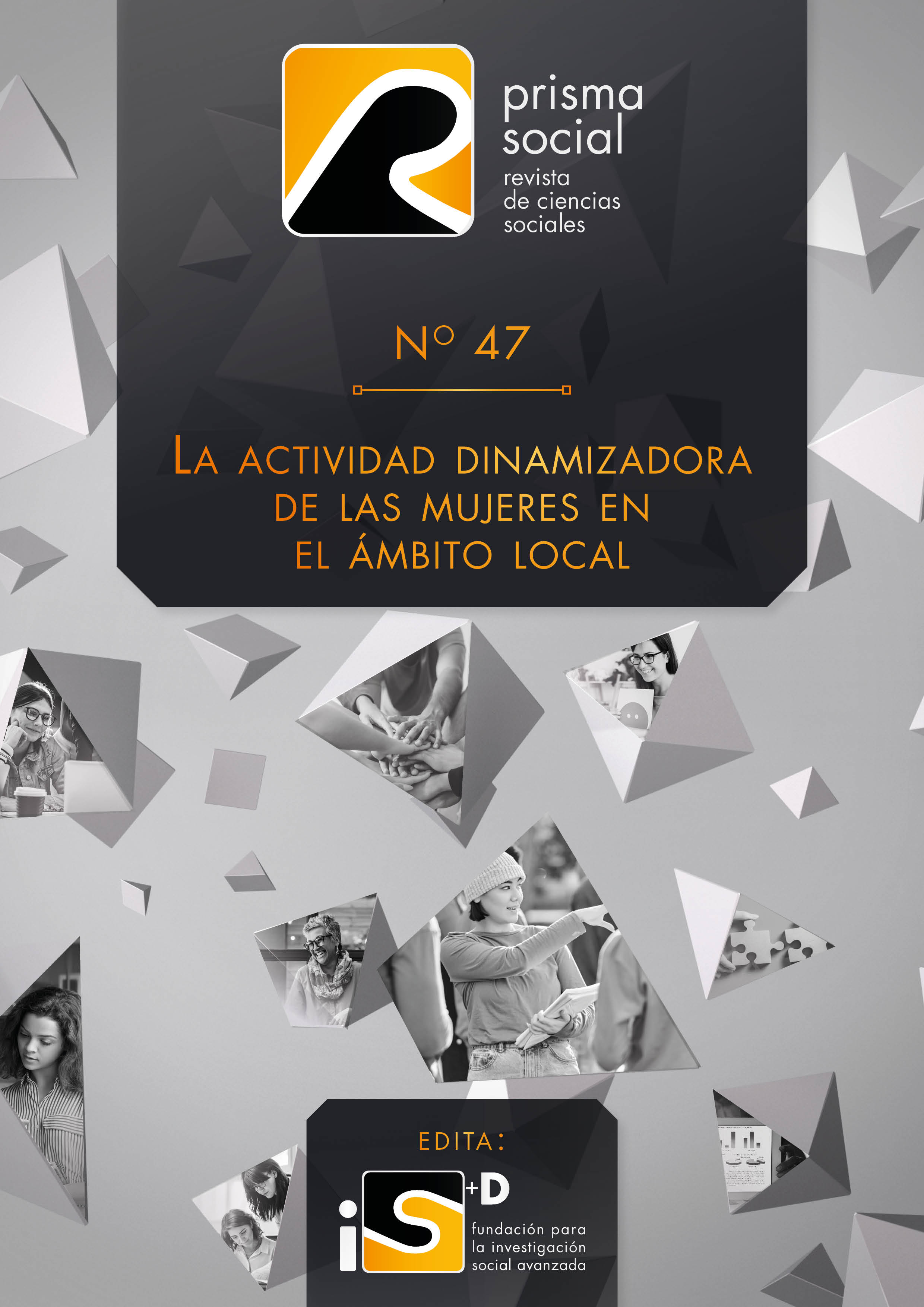




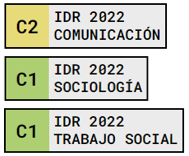

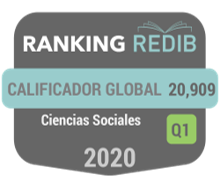
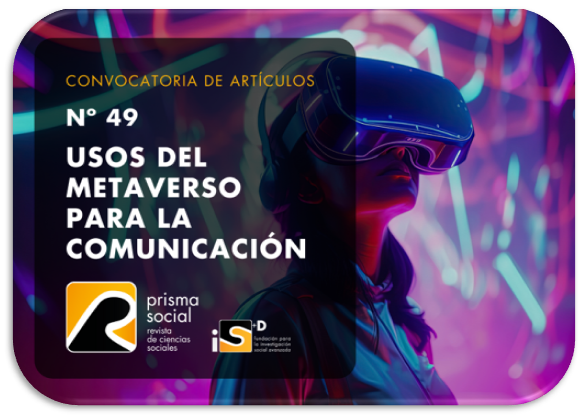
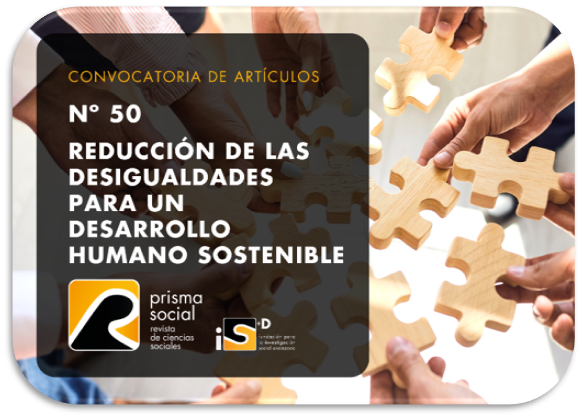








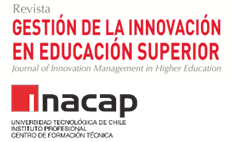



.png)




